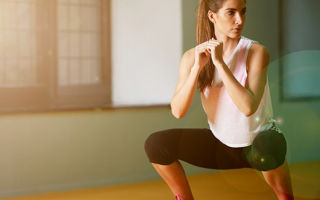Content
Squats are a basic exercise in any classic workout. They have become popular for their ability to strengthen the muscles of the legs and buttocks. However, the possibilities of exercise for the body are wider than commonly believed. Before training, it is important to have a good idea of the benefits and harms of squats, assess your physical condition and the expected effect of exercise.
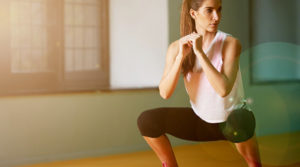
What are squats
Squats are aimed at strengthening muscles, which is why they are included in most training programs. This movement, very natural for a person, despite all its simplicity, perfectly maintains the muscles of the lower body in good shape. To perform the exercise, no special equipment or special physical skills are required: lifting and lowering the trunk is performed by bending the legs at the knees.
There are several types of squats, each with its own unique and beneficial properties that target specific muscle groups. Based on the training goals, you can choose the option that suits you best.
The benefits of squats
Squats are not difficult to do, but the properties of such an exercise definitely have great benefits for physical condition and health:
- Build muscle mass... Thanks to squats, the quadriceps and calf muscle fibers, hamstrings and others are actively worked out. Exercise tends to increase the body's production of testosterone and growth hormone, thereby stimulating effective muscle building. The benefits of squats with a barbell or dumbbells for the arms are manifested in the activation of the muscles of the biceps and triceps.
- Fat burning... Actively working out the muscles provokes the burning of fat in the body. By building up muscle fibers, the body spends calories, thereby getting rid of the stored fat cells. That is why squats are invaluable for girls who want to lose those extra pounds.
- Maintaining body mobility... In addition to strengthening the lower body, squats are also capable of maintaining the mobility of the whole body.
Interesting! Exercising at full amplitude helps develop all of the major leg muscles, which helps prevent fatigue after prolonged physical activity.
- Improved coordination... To this property of the squat can also be added the development of body mobility, which in turn contributes to the improvement of strength skills and the growth of muscle mass. Squats provide the foundation for other calf exercises, such as single-legged squats or calf raises.
- Physical development... In addition to the benefits for certain areas of the body, squats can significantly improve the physical capabilities of the whole body: for example, after regular training, jogging distance or jump length can increase imperceptibly. Squats also help improve performance in other sports, be it tennis or gymnastics.
- Preventing injury... By developing more accessory muscles in the lower region, the risk of injury or damage to muscle fibers is greatly reduced. The beneficial properties of squats contribute to the well-coordinated work of muscles and joints while maintaining a stable body position. It is only important to observe the correct exercise technique and adhere to the recommendations.
- Development of sphincters of the central part of the body... Another useful property of squats is their use of the central part of the body, including the abdominal area. Interesting to know! Research in 2009 showed that exercise can put more stress on your abs than regular crunches. And squats on one leg tend to include a large muscle mass in the work, with the benefit of working out the muscles of the legs and buttocks.
- Improving joint health... Lifting the body during the squat synchronizes the work of the hip joint, knees and ankle, evenly distributing the load and thereby reducing the risk of damage.
- Helping the heart... Squats are invaluable for heart function. Unlike most strength exercises, squats do not load the heart muscle; on the contrary, they normalize its functioning. They can also serve as an excellent cure for diseases such as ischemia or arrhythmias of the heart.
For women
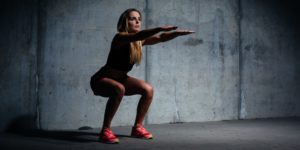
- Working out the main muscles... Almost every girl and woman dreams of having a beautiful and fit figure, and squats are a great helper in this matter. The secret is that the properties of such an exercise will be useful in using a wide variety of muscle groups: in addition to the sphincters of the buttocks and legs, it also works out the abs and back. Thus, one exercise can replace several at once.
- Ideal figure. Another useful property of squats for girls and women: regular exercise will help you quickly lose extra pounds, tighten your figure and form the correct posture. Squats are also a good helper in the fight against female cellulite problem.
- Improving blood flow... The functioning of the vessels in the pelvic area is significantly improved. That is why the benefits of squats are so relevant for women after 40: they will help to improve metabolism, tighten the skin in different parts of the body and significantly improve its appearance.
For men

- Increased blood flow... Active stimulation of blood circulation in the pelvic area improves microcirculation in all major tissues of this area. As a result, the skin becomes firmer and tighter.
- Working out the muscles of the press, back, formation of correct posture.
- Helping the cardiovascular system... Squats with their own weight are of great benefit for men: their properties to strengthen the heart and blood vessels help turn exercises into a full-fledged cardio workout.
- Normalization of metabolism... By accelerating the metabolism, the body burns fat cells much more actively and gets rid of the harm of accumulated toxins. Active fat burning, in turn, helps to build muscle mass.
Squats are also beneficial for men's health, because during intensive training in the gym they protect the joints from damage.
Are squats good for kids
Despite the doubts of many parents, squats are a general strengthening exercise that cannot harm the child's body. It is actively used in physical education lessons in schools and sports clubs, be it swimming or basketball.
The properties of squats will be useful in the formation of an even posture, and in significant strengthening of the articular apparatus (especially the lower limbs, ligaments and tendons).
Moreover, the risk of harm to a child's body from squats is much lower than that of an adult.Squats will help in building a strong skeletal system, and will also be an excellent way to release accumulated children's energy.
How to squat correctly
Before you apply all the useful properties of squats to yourself, you need to familiarize yourself with the rules for performing exercises: to prevent possible harm and enhance the benefits of training:
- Movements should be carried out smoothly and softly, without sudden jerks. You need to do the exercise thoughtfully and slowly, while trying to feel every muscle in the body. If pain occurs, you should stop exercising and give the body time to rest.
- The best training option for beginners is 3 sets of 12 reps.
- Deep squats are especially useful for working out the calf muscles. To perform them, you must lower the body as low as possible.
- Your knees should always be above your feet, you do not need to bring your legs together or apart.
- The main body weight is transferred to the heels. Feet should be firmly pressed to the floor, you should not tear your legs off the surface or stand on your toes. Only in this way will the gluteus muscle and hamstrings receive maximum stress.
- There is a classic scheme of the correct body position for performing squats: you need to stand up straight with your feet shoulder-width apart. Take the pelvis back, imagining that there is an invisible chair behind. A small box or stool will be great helpers for self-control. Do smooth squats, while taking deep breaths in and out.
Types of squats and their benefits
In sports, there are several useful types of squats, each of which has its own unique properties. It is important to familiarize yourself with the features of each option in order to choose the most suitable one for yourself.
Classic squats
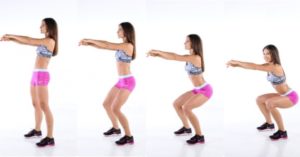
This type of exercise is aimed at evenly working out all the leg muscles. Regular squats are useful for training the quads, adductors, glutes, and soleus.
Standing straight, you need to place your feet at the width of the pelvis, and your arms along the body. Taking a breath, take your pelvis back and bend your knees at a right angle. On exhalation, return to the starting position.
Plie
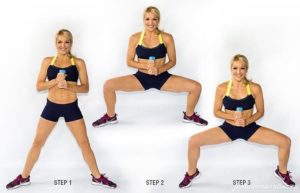
The benefits of plie squats helps to work out the gluteal and quadriceps muscles of the thigh, as well as its inner surface.
The techniques for performing plie squats and classic squats are similar to each other, the only difference is in the starting position: in plie, with your feet shoulder-width apart, you need to turn the socks outward at a right angle, and put your hands on your belt.
Sumo
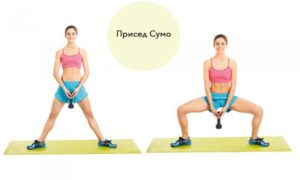
Sumo squats are aimed at a comprehensive study of the muscles of the legs, buttocks and thighs. They develop flexibility in the hip joints and improve overall body mobility.
For the sumo position, you need to spread your legs wide apart, while turning your socks outward. Take your hips back and sit down until a right angle is formed at the knees, then tighten the gluteal muscles as much as possible and return to a standing position.
Jump squats
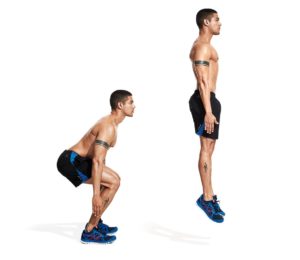
The benefit of the jump squat is to increase the efficiency and intensity of your workout.
Put your feet shoulder-width apart, while inhaling, bend at the knees, and while exhaling, jump up sharply. When the feet touch the floor surface, you need to immediately perform the next squat.
Wall squats

When doing squats against the wall, the quadriceps and gluteus maximus muscles are actively worked out, and the exercise is most effective when weights are added. Wall squats also have benefits for the calf and soleus muscles.
Starting position for exercise:
- Press your back, shoulder blades and buttocks tightly against the wall.
- Place feet shoulder-width apart and bend slightly at the knees.
- Bend your elbows and fold in front of you, one on top of the other.
Performance:
- Taking a breath, without lifting the upper body from the wall, it is necessary to sit down so that the lower leg and thigh form a right angle at the knee.
- Then you need to exhale, while straining the quadriceps, and return to the starting position.
Scissors
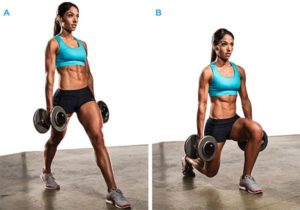
During the exercise, you can shift the main load to the anterior or posterior muscle groups. It all depends on the width of the leg position: if you put the leg further, the main load will fall on the gluteal muscles and the back of the thigh. Bringing the legs closer together helps to develop the quads.
You need to pick up a barbell and throw it over your shoulders. With your feet shoulder-width apart, you need to take a step forward. It is very important to control the back: it should be in a straight position, with a slight bend in the lower back.
After that, do a squat, while bending both legs at the knees. It is also important to ensure that the knee of the front leg does not extend beyond the foot. The knee of the other leg should touch the floor surface.
As you exhale, you must take an upright position.
Squats with a barbell or weights
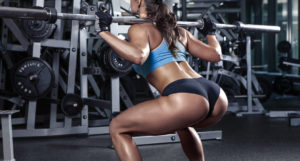
Barbell squats are not only beneficial for beautiful, toned buttocks. Such squats significantly improve health: their useful properties include strengthening joints and tendons, getting rid of back pain and normalizing heart function. They are able to speed up metabolism and rid the body of the harm of accumulated toxins.
Starting position - feet shoulder width apart, take a weighting agent in your hands. Deep squats smoothly. It is important to ensure that your knees do not go over your toes. On exhalation, return to the starting position.
The benefits of squatting without weight are to build endurance, burn excess fat, and strengthen your glutes and thighs.
Slimming squats
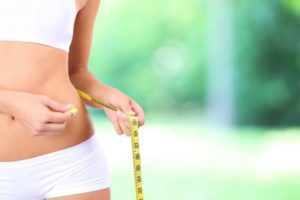
Squats are included in most training programs to maintain muscle tone and lose weight.
Classic squats are considered to be the most useful and effective in the fight against extra pounds: they actively strengthen the muscles of the body and contribute to effective fat burning. In the first week of classes, you must do at least 3 workouts of 15 - 20 approaches with a break of 8 - 10 minutes. However, you should not be zealous with the number of repetitions - excessive efforts can reduce the effectiveness of the exercises and harm the body.
In order to calculate how many calories in the body squats burn, you need to multiply your weight by 0.1. The resulting number is the number of calories burned with squats in 1 minute. So, if a person's weight is 70 kg, in 1 minute of exercise his body will burn 7 kcal, in 10 minutes - 70 kcal, respectively.
For beginners, it is recommended to start with 25 squats per set, (on average, you need to do three sets in one session), gradually increasing the load. In one such workout, the body can burn from 100 to 200 kcal: it all depends on the intensity of the exercise.
Squats for the buttocks
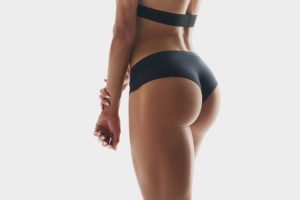
Squats are the most useful and effective exercise for building a beautiful butt shape. This is influenced by several factors: the shape of the pelvic bone, the volume of the fat layer and the condition of the muscles.
If the size of the bones remains unchanged, then the beneficial properties of squats can be manifested in a decrease in body fat reserves and in working out muscles. However, one should not expect the first results after a week of training: they can be seen only after a month of active training. It is very important to combine squats with other glute-training exercises such as scissors, cycling, lunges and planks. Squats can also help shape beautiful and lean legs and improve overall women's health.
The greatest benefit for girls who want to pump up beautiful buttocks are deep squats (sumo): this is the main and irreplaceable exercise in building a beautiful figure. It is optimal to perform three sets every 2 to 3 days, combining squats with other exercises.
How many squats to do
Beginners who are just starting to master the squat technique should be done no more than 30 times in 1 - 2 sets. Start with 10 - 15 times in one approach and increase the load over time. When the squats begin to be performed easily and without difficulty, you can connect various weights with a weight that allows you to do the same 10-15 times per set.
There is a unique "Thousand Squat Method". It may seem to some that it is impossible to complete 1,000 squats per day. But this technique implies an even distribution of the load: you need to do only 10 repetitions in one approach throughout the day, increasing this number over time. Soon the body will be able to do 100, 200, 500, and then 1,000 squats per day without much difficulty.
Trainers recommend doing squats in the morning when the muscles are most adapted to work: then the exercise will be most beneficial.
Harm of squats and contraindications
Despite all the beneficial properties, even such an easy-to-perform exercise can cause serious harm to the body.
- The greatest danger is squatting with weights: they put a serious load on the knee joints, which are not always able to withstand it. This often applies to people who prefer strength sports. In order not to harm the tendons and joints of the knee area, before training, it is necessary to warm up the muscles, which will significantly reduce the risk of injury.
- Squats are strictly contraindicated in people with knee diseases, since exercise can only increase inflammation and provoke immediate joint destruction.
- It is not allowed to squat for problems with the spine, scoliosis and diseases of the cardiovascular system. In this case, a doctor's consultation is required.
- Another possible harm factor is being overweight, which puts additional pressure on the knee joints. That is why overweight people need to do the exercise especially carefully and prudently. Start with a small number of repetitions to follow the body's response. Special bandages are also recommended for knee joints.
Conclusion
The benefits and harms of squats continue to be actively studied by experts in the field of sports training. To date, many useful properties of this exercise have been discovered: active study of the main muscles of the body, the formation of correct posture, stimulation of fat burning, as well as the normalization of the cardiovascular system.
When performing squats, you must follow the main rules and first familiarize yourself with the contraindications for classes.
Reviews and results


